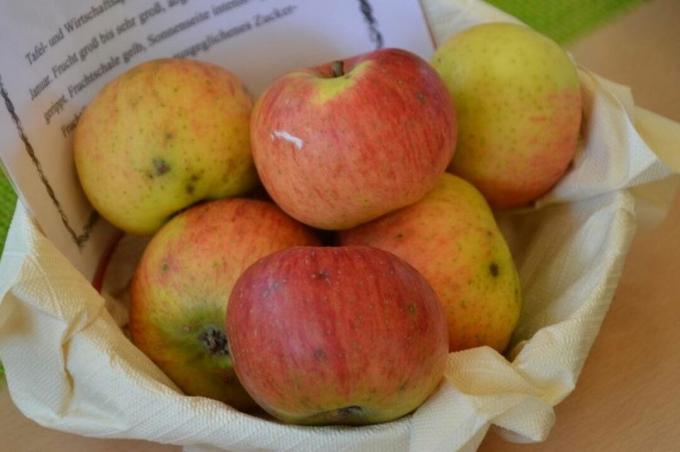Anyone looking for an uncomplicated and versatile apple tree for the home garden or orchard should take a closer look at the 'Josef Musch' variety. We present the undemanding apple variety.

The 'Josef Musch' apple is a highly recommended variety for the home garden. In addition to the low demands on soil and climate, the medium-strong growth is an advantage that is particularly useful in small gardens. The fruit of 'Josef Musch' is tasty enough to be used as a dessert apple, but is also very suitable for processing and cidering. Because the tree is also robust against cold and pests, 'Josef Musch' can rightly be described as a worthwhile purchase for the meadow orchard and the private garden.
contents
- Josef-Musch-Apfel: profile
- origin and history
- Taste and characteristics of the apple 'Josef Musch'
- Cultivating and caring for Josef Musch: This is how it works
- Apple variety 'Josef Musch': harvest and use
Josef-Musch-Apfel: profile
| synonyms | 'mush' |
| fruit | large to very large; Greenish to straw yellow ground color with carmine red top colour |
| the taste | full-bodied, slightly acidic |
| yield | medium to high, hardly fluctuating |
| harvest time | mid-September to October |
| maturity | from November on |
| shelf life | Good; can be stored until February |
| growth | initially medium strong, later weaker |
| climate | low claim |
| diseases and pests | robust against diseases; susceptible to comma scale insects |
origin and history
Joseph Musch was the discoverer of the random seedling and thus gave his name to the apple variety 'Josef Musch'. It was first mentioned in writing in 1872 and is presented in detail in the Pomological Monthly Bulletin of 1881. The rambur-shaped fruit is closely related to 'Baumann's Renette' and is still successfully cultivated today, especially at high altitudes.
Taste and characteristics of the apple 'Josef Musch'
The fruit of the apple variety 'Josef Musch' is large to very large and visually a typical Rambur. The shape is thus spherically flattened and has wide, clearly visible edges. The stem is thick and short. Sometimes the halves are unequally pronounced due to incomplete fertilization. The basic color of the skin is greenish yellow and straw yellow when fully ripe. The bright crimson, washed-out and streaked color covers almost the entire fruit. The apple can be heavily rusted, often there are net-like patterns and many large rust spots or warts around individual lenticels. The shell is rather coarse and firm. The pulp inside has clearly visible green vascular bundle lines. It is whitish-yellow and has large cells, is not very crisp and not very juicy, but has a good, full-bodied taste with little acidity. The ripe Josef Musch apple smells strong.

Cultivating and caring for Josef Musch: This is how it works
The apple tree of the 'Josef Musch' variety is a comparatively undemanding tree. Although it prefers nutrient-rich, loamy soil and does not tolerate constantly dry soil very well, it has few other requirements. With sufficient Fertilization of the apple tree the variety does well in almost all garden soils and also in different climates.
Especially at altitudes of over 500 meters above sea level, the low climate requirements of 'Josef Musch' are a popular feature. Even with cold winds and cool summers, the fruits still ripen reliably.
The growth of the strain is medium strong when young and slows down later. The tree is usually only medium-sized, although growth and final size are of course influenced by the rootstock used. The branching of the tree is only weak, so that the crowns tend to be light and senile. Regular pruning to maintain vitality is therefore very important with 'Josef Musch' in order to always generate young fruit wood that forms high-quality apples.
The variety can be raised as a half-stem, standard or as a shaped fruit - such as trellis fruit.
The flower appears early to mid-early with large petals. The varieties 'Baumanns Renette', 'Cox Orange', 'Croncels', 'Yellow Belle Fleur', 'Yellow Noble Apple', 'gold parmesan‘, ‘Landsberger Renette‘, ‘ontario' and 'White Klarapfel' are suitable. On the other hand, the pollen from 'Josef Musch' cannot contribute to the pollination of these varieties, because the variety is triploid, i.e. it has a triple genetic makeup and is therefore not compatible with diploid varieties such as those mentioned above. It is therefore better to have two types of pollinators nearby so that they can also pollinate each other.
Regular fertilization ensures medium to high yields, but excessive potassium fertilization can lead to a relative calcium deficiency, which then causes the fruit to become pitted. It is therefore very important to use slow-acting, organic fertilizers when fertilizing.
The apple tree 'Josef Musch' is very resistant to diseases, but according to experience reports it is preferentially attacked by scale insects.
Apple variety 'Josef Musch': harvest and use
Depending on the weather, the 'Josef Musch' apple is ready to pick from around mid-September and the harvest continues until October. Apples picked early are stored and last until February. However, the fruit should definitely be checked regularly in the apple storage because they tend to rot when stored. The Josef Musch apples are ready to eat on the tree from November. Use as a table apple is only second to 'Josef Musch', although the taste is good. Because it produces particularly delicious juices and purées, the apple is primarily used for cider and processing.
Anyone who creates an apple orchard should choose varieties that complement each other. So it is with the varieties'Landsberger Renette' and 'Josef Musch': They are harvested at about the same time and the Landsberger Renette is a wonderful, aromatic dessert apple.
